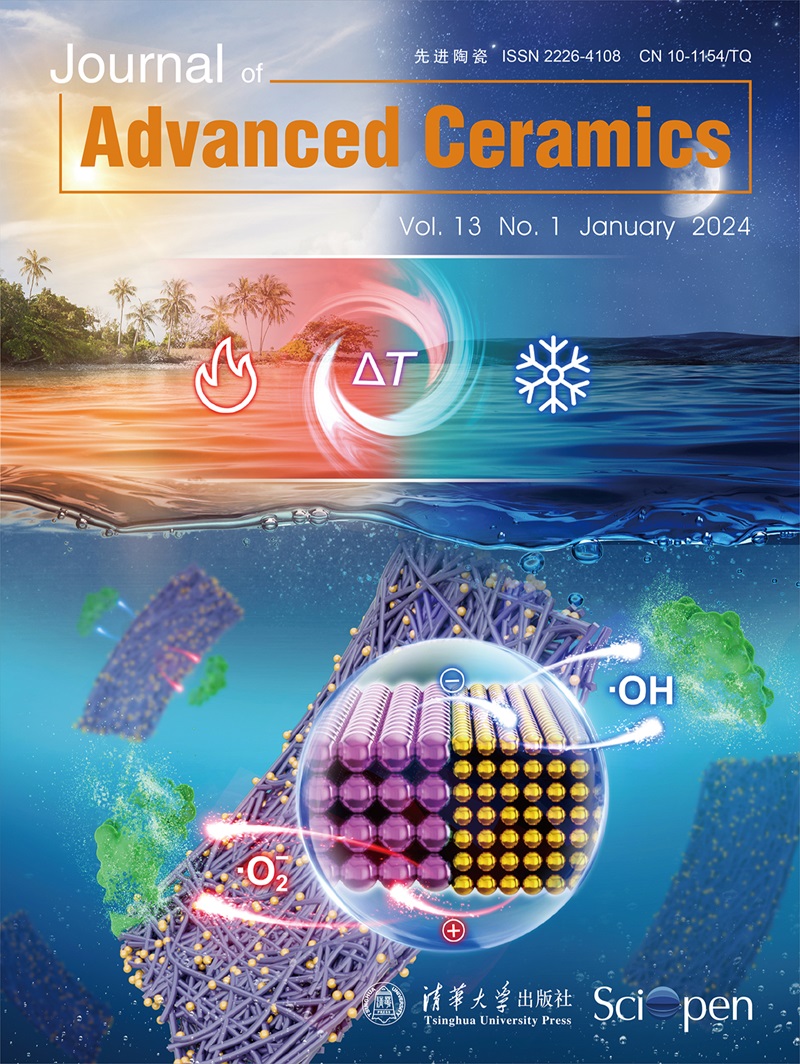通过KCl选择性溶解了解n型bi2te - 3合金组织设计中二次相夹杂物和成分变化
IF 16.6
1区 材料科学
Q1 MATERIALS SCIENCE, CERAMICS
引用次数: 0
摘要
研究了KCl处理对n型Bi2Te2.7Se0.3 (BTS)热电材料微观结构和热电性能的影响。创新的KCl处理最初旨在通过选择性溶解热电材料和KCl的混合物中的KCl来引入纳米孔。然而,在随后的放电等离子烧结(SPS)过程中,它意外地引起了材料成分和微观结构的实质性变化。溶解过程中羟基被吸附在粉末表面,经过450℃的SPS处理后,BTS基体内出现了Bi2TeO5次级相。随着KCl含量的增加,Bi2TeO5的浓度增加。此外,在低KCl浓度下,晶粒生长显著,可能是由于SPS过程中富te成分的液相形成。然而,高浓度KCl下过量的Bi2TeO5阻碍了晶粒的生长。这些微观结构的变化对电学性能产生了复杂的影响:TeBi反位缺陷增加了电子浓度,而Bi2TeO5降低了电子迁移率。此外,由于Bi2TeO5的存在,晶格热导率从原始BTS在298 K时的0.8 Wm-1K-1下降到经1 wt% KCl处理的BTS在298 K时的0.6 Wm-1K-1。这些发现允许对电导率和导热率进行精确调整,通过选择性溶解KCl方法将ZTmax从0.76提高到0.96。我们相信,我们的观察有可能通过工程微结构推动热电材料的进步。本文章由计算机程序翻译,如有差异,请以英文原文为准。
Understanding secondary phase inclusion and composition variations in the microstructure design of n-type Bi 2Te 3 alloys via selective dissolution of KCl
This study investigated the effects of KCl treatment on the microstructure and thermoelectric properties of n-type Bi2Te2.7Se0.3 (BTS) thermoelectric materials. The innovative KCl treatment was originally intended to introduce nanopores through the selective dissolution of KCl from a mixture of thermoelectric materials and KCl. However, it unexpectedly induced substantial variations in the material composition and microstructure during the subsequent spark plasma sintering (SPS) process. The hydroxyl groups adsorbed on the powder surface during the dissolution resulted in the emergence of a Bi2TeO5 secondary phase within the BTS matrix after the SPS process at 450 °C. The concentration of Bi2TeO5 increased with an increase in the KCl content. Furthermore, a remarkable grain growth occurred at low KCl concentrations, likely due to the liquid-phase formation in a Te-rich composition during SPS. However, excessive Bi2TeO5 at higher KCl concentrations hindered grain growth. These variations in the microstructure had complex effects on the electrical properties: the TeBi antisite defects increased the electron concentration, and Bi2TeO5 reduced the electron mobility. Additionally, the lattice thermal conductivity decreased due to the presence of Bi2TeO5, from 0.8 Wm-1K-1 at 298 K for the pristine BTS to 0.6 Wm-1K-1 at 298 K for the BTS treated with 1 wt% KCl. These insights allowed precise adjustments of the electrical and thermal conductivities, leading to an enhancement in ZTmax from 0.76 to 0.96 through the selective dissolution of KCl approach. We believe that our observations potentially enable advances in thermoelectric materials by engineering microstructures.
求助全文
通过发布文献求助,成功后即可免费获取论文全文。
去求助
来源期刊

Journal of Advanced Ceramics
MATERIALS SCIENCE, CERAMICS-
CiteScore
21.00
自引率
10.70%
发文量
290
审稿时长
14 days
期刊介绍:
Journal of Advanced Ceramics is a single-blind peer-reviewed, open access international journal published on behalf of the State Key Laboratory of New Ceramics and Fine Processing (Tsinghua University, China) and the Advanced Ceramics Division of the Chinese Ceramic Society.
Journal of Advanced Ceramics provides a forum for publishing original research papers, rapid communications, and commissioned reviews relating to advanced ceramic materials in the forms of particulates, dense or porous bodies, thin/thick films or coatings and laminated, graded and composite structures.
 求助内容:
求助内容: 应助结果提醒方式:
应助结果提醒方式:


